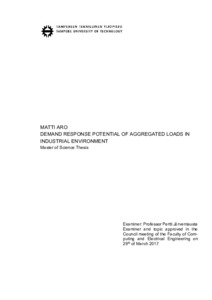Demand Response Potential of Aggregated Loads in Industrial Environment
Aro, Matti (2017)
Aro, Matti
2017
Sähkötekniikka
Tieto- ja sähkötekniikan tiedekunta - Faculty of Computing and Electrical Engineering
This publication is copyrighted. You may download, display and print it for Your own personal use. Commercial use is prohibited.
Hyväksymispäivämäärä
2017-10-04
Julkaisun pysyvä osoite on
https://urn.fi/URN:NBN:fi:tty-201709261965
https://urn.fi/URN:NBN:fi:tty-201709261965
Tiivistelmä
In the power system, electricity production and consumption must be constantly balanced. Without balance, the frequency of the power system deviates from its rated value and that may result in device failures and large-scale power outages. In the Nordic area, power grids of Finland, Sweden, Norway and East Denmark are synchronously connected, which means that the grid frequency in these areas is the same at all times. In Finland, the power balance is maintained by Finnish Transmission System Operator, Fingrid, by managing the power reserve market which aim to ensure the power balance also in the cases of disturbances.
In order to maintain the power balance, the production and consumption of electricity must continuously be regulated. Traditionally, the balance has been maintained by regulating the production side. As renewable, weather-dependent power generation, such as solar and wind power, has become more in common, the production side is losing its controllability. The demand side has to engage in the balancing more heavily than before. Demand Response means controlling consumption, for example, on the basis of electricity price signal. Shifting consumption from times of high electricity prices to lower ones helps also the power system because high electricity price is a sign of electricity shortage.
The aim of this thesis was to find out the Demand Response potential of Rauma paper mill, which is part of a Finnish forest industry company UPM. The aim was also to develop a generalized method for identifying flexible loads in an industrial environment and an analysis tool to guide them to the most profitable DR markets. The DR potential mapping was carried out in stages, of which the most important were: collecting the data of all motors in area, defining the most crucial boundary conditions and finding motors that meet them, and analyzing the found potential.
Based on this study, the paper industry in general holds a significant potential to participate in DR markets. Some of this potential could be utilized in the DR market almost without any investment. At least this potential should be harnessed to produce additional value.
In order to maintain the power balance, the production and consumption of electricity must continuously be regulated. Traditionally, the balance has been maintained by regulating the production side. As renewable, weather-dependent power generation, such as solar and wind power, has become more in common, the production side is losing its controllability. The demand side has to engage in the balancing more heavily than before. Demand Response means controlling consumption, for example, on the basis of electricity price signal. Shifting consumption from times of high electricity prices to lower ones helps also the power system because high electricity price is a sign of electricity shortage.
The aim of this thesis was to find out the Demand Response potential of Rauma paper mill, which is part of a Finnish forest industry company UPM. The aim was also to develop a generalized method for identifying flexible loads in an industrial environment and an analysis tool to guide them to the most profitable DR markets. The DR potential mapping was carried out in stages, of which the most important were: collecting the data of all motors in area, defining the most crucial boundary conditions and finding motors that meet them, and analyzing the found potential.
Based on this study, the paper industry in general holds a significant potential to participate in DR markets. Some of this potential could be utilized in the DR market almost without any investment. At least this potential should be harnessed to produce additional value.
